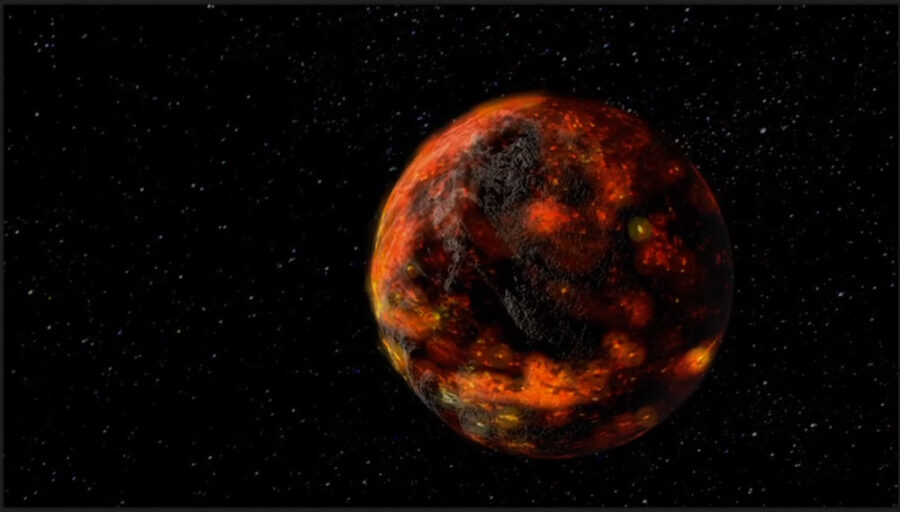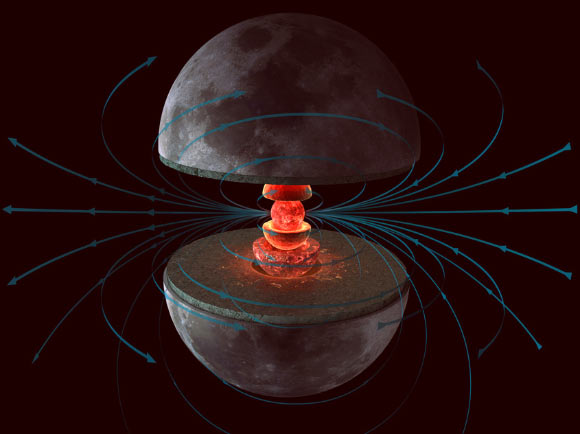Could the Moon have made life possible on Earth?

NASA Goddard Space Flight Center
Scientists already suspect that the Moon had a stabilizing effect on our planet’s spin through the ages. Now, new research suggests that the Moon’s magnetic field — if it had one — could have shielded Earth’s atmosphere from being stripped by the young Sun’s radiation.
Previous research by John Tarduno (University of Rochester) and colleagues had shown that the young Sun was fierce, emitting high-energy radiation at levels much greater than today, which would have helped strip away some of Earth’s atmosphere — including significant amounts of water. It could be that the young Earth simply had a larger water inventory, Tarduno’s team suggested, so it could afford to lose some.
But James Green (NASA) and colleagues suggest an alternative in the October 14th Science Advances: Perhaps Earth had a little help. While the young planet’s global magnetic field might not have been strong enough to shield it, the combined magnetic fields of both Earth and the Moon may have done the job.
Green’s team bases their concept on a recent re-analysis of Apollo lunar samples, which suggested that the young Moon hosted its own magnetic field with a strength that rivaled Earth’s between 3.5 and 4.25 billion years ago.

Hernan Canellas / Benjamin Weiss / MIT
Back then, the newly formed Moon orbited Earth more closely, at about a third of its current distance. Green and colleagues use simple calculations to show that the two bodies’ magnetic fields would thus have been connected, protecting both of them from solar radiation.
The authors acknowledge that their model is simple but offer it as proof of viability: “Having now established this concept, additional modeling can be conducted with more complicated, and potentially more realistic, configurations,” they write.
More Data Needed
“The Achilles heel of this study, in my opinion, is the unquestioned assumption that the Moon had a strong past magnetic field,” says Tarduno, who was not involved in the new study. “While some lunar rocks appear to have strong magnetizations, many others do not. While small areas of the lunar crustal appear magnetized, there are huge areas without magnetic signals.”
Even if the Moon did have a global magnetic field early on, Tarduno adds, the strength and durability of the field remain open questions.
As NASA gears up to return to the Moon with its Artemis initiative, future exploration and even additional sample returns could shed more light on whether and how much the lunar magnetic field affected the Moon itself and its surroundings.
The Moon’s protective effect implies that exomoons might be a characteristic of life-hosting exoplanets, too. But if the Moon in fact did help Earth on its way toward hosting a biosphere, unraveling the more general role of exomoons will take some time. “Regarding whether moons exist around temperate rocky planets,” says exoplanet expert Eric Mamajek (NASA JPL), “I suspect that astronomers are many years away from any reliable detections.”
 3
3









Comments
Marc-Andre Paradis
October 23, 2020 at 4:18 pm
High energy radiation = photons of high energy. These are not charged particules, they are photons. I thought that they do not interact with a magnetic field!?
You must be logged in to post a comment.
robin_astro
October 23, 2020 at 7:52 pm
Indeed. high energy protons (ie solar wind) not photons
You must be logged in to post a comment.
Monica YoungPost Author
October 29, 2020 at 10:43 am
I'm assuming you are referring to the paragraph on previous research conducted by John Tarduno et al. on the effect of high-energy radiation on Earth's atmosphere. This paragraph is referring to photons, not protons, as the photons would both heat and ionize the atmosphere, aiding atmospheric escape. But you're right that the solar wind was also correspondingly higher at early times, and also helped stripped the atmosphere, and indeed the Moon's magnetism would have protected against the solar wind but not against solar radiation. I've edited the paragraph to clarify.
You must be logged in to post a comment.
You must be logged in to post a comment.